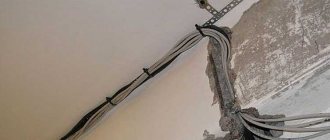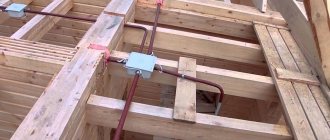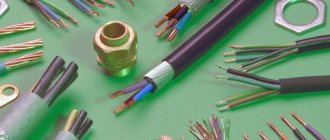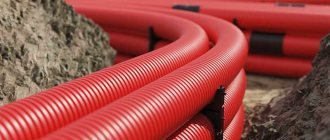Cable on the fence: what do PUEs say about this?
Actually, there is no such concept as a “fence” in the Electrical Installation Rules.
There is a definition: “...cables laid along structures and walls...”. For such cases, there are many rules and restrictions. At least one thing is clear: this will be an open gasket, with all the ensuing consequences. For example, geometry: depending on the height of the power wire route, it should have different degrees of protection. The material of the base of the wall (structure) also affects the laying conditions.
We will not try to find special privileges or restrictions for fence power networks. Let's look at the rules related to the definition of “construction...”.
Installation requirements
The entire set of elements intended for laying a cable in a classic design is called a cable structure; the fence on the site is not included in this category. The PUE allows installation on so-called non-cable structures, which can be a fence, but during installation it is necessary to fulfill the conditions so as not to deviate from the requirements of regulatory documents.
Installation requirements are much lower if an armored conductor is used for installation, but this is not always convenient and affordable, so in the future we will consider the option of working with PVS or VVGng-LS cables, which have deservedly won the widest use due to the successful combination of such parameters, both price and quality. Their conductors are made of copper, and the insulation is made of polyvinyl chloride (PVC).
PVS and VVG cables, as unarmored ones, must be laid at a height of at least 2 meters, otherwise they must be protected from mechanical damage, that is, in accordance with the PUE, they must be laid in a pipe, in a box or protected with a steel corner etc., as specified in paragraph 2.3.39 of the PUE (Chapter 2.3).
2.3.127
The height of cable wells must be at least 1.8 m; The height of the chambers is not standardized. Cable wells for connecting, locking and semi-locking couplings must have dimensions that ensure installation of the couplings without tearing.
Coastal wells at underwater crossings must be sized to accommodate backup cables and feeders.
A pit must be installed in the floor of the well to collect groundwater and storm water; a drainage device must also be provided in accordance with the requirements given in 2.3.114.
Cable wells must be equipped with metal ladders.
In cable wells, cables and couplings must be laid on structures, trays or partitions.
Basic cable laying methods
Cables can be laid:
- in open areas;
- along the walls of buildings and structures;
- in the ground.
There are two ways to lay the cable: open and hidden. Open installation of the cable is allowed on special supports, poles, walls of buildings and other structures, provided it is protected from mechanical damage and laid at a height of at least 2 m. Open laying of armored cables underground is permitted. In other cases, only hidden cable installation is permissible:
- in boxes, pipes, reinforced concrete trays;
- in blocks or channels;
- in the trenches.
If the above requirements are met, it is allowed to lay the cable along the fence. The fence can be made of stone, reinforced concrete, plastic or wood. It is not recommended to lay the cable over a metal fence.
Options for laying wires and cables on various bases
Rules for laying electrical wires and cables vary greatly, depending on the type and material of the base through which they pass. For example, in a wooden or frame house, electrical wiring is performed differently than in a house made of foam block or brick.
Let's figure out exactly what and when cable laying methods are used, which installation methods are the most convenient and preferable, and which are strictly prohibited.
I would like to note right away that existing rules and regulations do not always have time to change and respond to the rapid development of modern electrical materials and construction technologies. Often, when choosing a laying method, we have to rely on outdated standards, which often approve and take into account only a very limited number of possible installation options.
From the point of view of electrical safety rules, all structures and foundations are divided into two main types: those consisting of combustible (combustible - SG) and non-combustible (non-combustible - NG) materials. Depending on this, the installation method is most often chosen.
Non-flammable materials include such materials as: Metals, natural stone, brick, concrete, aerated concrete, ceramics, glass, asbestos cement, plasterboard, foam concrete, expanded clay concrete blocks, cementitious concrete blocks, etc.
Combustible materials include: wood, sip panels, polycarbonate, polystyrene foam, siding, sandwich panels, bitumen and tar materials, plastics and some others. Therefore, when choosing a method for installing cables, it is necessary to start from this, from the base material.
IMPORTANT! All the rules below have been developed for cables permitted for installation in residential premises - in particular VVGng-LS , which are flame retardant and have low levels of gas and smoke emission.
Structural differences of SIP
In networks with voltages up to 1 kV, only two types of insulated wires are used, although there are more of them. To understand what the difference is between them, we have provided a small informational list:
SIP – 1
- SIP-1 is a bundle of twisted phase wires with insulation and one uninsulated neutral conductor made of high-strength ABE alloy. Has from one to four conductive cores.
SIP - 2 A distinctive feature of SIP-2 is the presence of insulation not only on the phase wires, but also on the neutral core, and naturally, it has a higher cost. That is why it is used mainly on high-voltage lines.
SIP - 4 This type of wire has at least two current-carrying wires, but it does not have a carrier (zero) wire. It is designed specifically for making branches from power lines towards buildings and laying along walls.
Note! Other types of SIP differ from each other not only in the type of insulation, but also in the number of cores. However, to carry out electrical inputs into the house, only SIP-1 and SIP-4 are most often used - the rest are intended for lines with voltages up to 35 kV.
Due to the presence of insulation, the SIP wire has an aesthetic appearance. This is, of course, an important nuance - but more for the consumer. Energy supply organizations value SIP because the insulation does not allow for “throwing” onto the wire, and thus using the resource bypassing metering devices. Another advantage is that the sheath makes it possible to connect two wires to each other without removing the voltage from them - however, this requires special fittings.
What types of grounding in a private house can you do yourself?
When building a house with your own hands, many people probably think about what types of grounding can be done with their own hands. If you have the necessary materials and tools to take the necessary measurements, organizing this is not difficult.
Grounding can be done independently, using available means: old pipes, rolled metal, fittings. The advantage of grounding of this type is ease of manufacture and low cost. Sometimes all costs are spent only on the purchase of welding electrodes. The disadvantage of this method is its short duration. After 10-15 years, the grounding loop will need to be replaced.
If funds allow, it is better to purchase modular grounding and assemble it yourself. This type of grounding is a ready-made kit. The advantage of this type is quick installation and long service life. The downside is the high price.
General safety rules for unprotected insulated wire
From the point of view of the danger of touch, an unprotected insulated wire is considered as uninsulated, that is, bare. What is an unprotected cable? This is a conductor that has only core insulation and an outer sheath (or without it, like self-supporting insulated wire). That is, under mechanical influence with a sharp object, you can touch the conductive wires.
A cable that has an armored sheath or is laid in a durable box (pipe) is considered protected.
- The distance from the ground to the unprotected wire must be at least 2.75 meters. That is, if your fence is at least 3 m high, the task is simplified.
- The shell material for open installation (without a protective box or sleeve) is selected taking into account the external environment. Protection from frost, overheating, ultraviolet sunlight.
- Of course, the insulation must be airtight.
- It is necessary to provide for temperature changes in length: both the fence and the cable. Under any conditions, the occurrence of gravitational force is unacceptable.
- Along their entire length, the wires must have access for visual inspection of condition and repair.
- At the connection points (boxes, couplings), it is necessary to provide a supply of wiring in the form of a loop for reconnection.
- It is prohibited to use the cable as a supporting structure for other objects (even if the cable is self-supporting).
An informal recommendation is that it is better to use a cable with a white outer sheath. On a bright sunny day, the wiring heats up less.
How to lay a cable along a fence according to the rules
Owners of country houses and household plots often have to deal with the problem of supplying power to consumers located in areas remote from their homes. This could be a pumping station, greenhouse heating devices, a lighting network, as well as a number of other economic facilities.
In such cases, the homeowner is faced with the question of how to route the power cable through the site without violating the Electrical Installation Rules (ERR), complying with all electrical fire safety standards, and also avoiding claims from control organizations.
The ideal solution to the problem would be to lay the wires underground in a cable channel or in a metal pipe, as well as suspend them on supports specially equipped for this purpose. However, these installation methods are very labor-intensive and can significantly hit the family budget.
In this regard, for summer residents and homeowners, laying cables along the fence is most relevant. We have provided below the installation methods and PUE requirements for laying the conductor.
Regulatory acts of process and technology
To correctly lay the wire in the trench, SNiP 3.05.06-85 “Electrical Devices” is used, as well as SNiP 12-03-99. These collections indicate the regulations governing electrical work, how to dig a trench, and the standards that must be followed when performing the procedure.
Additionally, the Construction Rules for Electrical Installations (PUE) are used in construction. The 7th edition of the PUE is studying this issue. The conditions for laying power cables underground are described in detail here.
For example, paragraph 2.3.17 of PUE-7 describes how to calculate the mass of wire, soil and road surface, and based on this, design an underground structure. In paragraph 2.3.83 of PUE-7, it is allowed not to additionally protect the cable with bricks or other structures if its voltage does not exceed 1 kV.
Norms and requirements
There are several requirements for laying wires in a rut:
- The depth should be such that it is impossible to dig a trench with a shovel. The degree of occurrence is regulated by the type of soil, the degree of its freezing and the groundwater level.
- The wire must be protected from mechanical damage.
- It is necessary to add sand to the trench: the sand cushion will not allow the wire to come into contact with solid soil.
- When laid under the road, a thick-walled metal pipe is used. This reduces the risk of damage due to excessive load on the coating.
Laying options
It is advisable to consider options for how to route the cable along the fence if the height of the fence reaches 2 meters or higher, or the fence is less than 2 meters high and is made of corrugated board, wood or brick. Let's consider the rules for laying the line in each case.
The height of the fence is from 2 meters. The simplest option, in this case there is no need to arrange cable protection from mechanical damage. It will be enough to stretch a steel cable with a diameter of 1-2 mm between the fence posts, to which the conductor is secured with nylon clamps, approximately as in the photo below. This installation method is the simplest to implement, requires relatively low material costs, and meets fire safety requirements if the fence is made of wood.
Methods for connecting wires to a support
To connect the SIP wire to current-carrying power lines on a support, several options are used, depending on the power line cable.
For insulated cable lines, special piercing clamps are most often used, which are available in a wide range for various sections and types of insulation. Some clamps can be used without removing the voltage from the line: in their design, the stripping head is made in insulation, which allows you to safely connect the self-supporting insulated insulated insulated wire to the power line. At the same time, the design of the piercing clamps does not allow them to be reused, so everything must be calculated correctly, without any room for error.
But for bare conductors, special clamps are used that have contacts with a smooth surface and do not have piercing elements.
When connecting a house to a power line, it is better to coordinate all actions with the energy supply organization. Such organizations may have their own requirements for connections and materials used.
Some “masters” lower the SIP along the pole and lay it underground to the house. But it is important to understand that a self-supporting SIP cable is not intended for such installation, since it does not have special protection from harmful influences and armor from mechanical damage, as a result of which it is intended only for laying in the air.
Types of grounding in a private house
Based on the type of grounding circuit, grounding is divided into artificial and natural.
The artificial is created deliberately in the process of organizing electrical networks. This type involves the presence of an artificially created grounding electrode that is in direct contact with the ground. This can only be a specially created circuit, the characteristics and parameters of which are carefully calculated.
Metal structural elements in contact with the ground can be used as natural soil. This could be unpaved railway tracks, steel pipes of wells, foundation reinforcement. Such designs cannot have precise parameters, so it is possible to use natural grounding to protect individual devices, but not the entire electrical system as a whole.
Cable protection requirements
The most stringent standard requirements apply to protection during underground installation. So, in the finished trench there should be a cushion of sand or granulated slag on which the slabs are placed. For models with voltages over 35 kV, the thickness of the plates must be at least 50 mm.
Lines of lower voltage may be protected not by slabs, but by baked clay bricks. But for this purpose it is strictly forbidden to use bricks with holes through which soil will enter when filling the trench. It is also prohibited to use sand-lime brick, since over time it loses its mechanical strength and cannot perform signaling functions. Since, in addition to protecting the cable sheath from damage, the brick must signal the location of the route section underneath it.
Since strong tension leads to a break when the temperature drops or when the soil moves, its location in the trench must be free. But you shouldn’t make too big waves either.
Rice. 4. Laying in the ground without tension
Is grounding necessary in a private house?
When using household electrical appliances, there is always a risk of damage to the wire insulation or short circuit to the housing. In this case, any entry of a person into the danger zone leads to electric shock, which can end tragically. The current always tends to the ground, and the human body becomes a conductor connecting the damaged device to the ground.
What does grounding do? In fact, it is a system that provides the shortest path for electrical current. According to the law of physics, he chooses the conductor with the lowest electrical resistance, and the circuit has this property. Almost all the current is directed to the system of grounding electrodes and therefore only a small part of it will pass through the human body, which cannot cause harm. Thus, the ground loop ensures electrical safety. Regulatory documents (GOST, SNiP, PUE) indicate that any private residential building should be equipped with alternating current networks for voltages above 40V and alternating currents above 100V.
In addition to ensuring safety, the grounding system increases the reliability and durability of household appliances. Ensures stable operation of installations, protection against overvoltage and various network interferences, and reduces the influence of external sources of electromagnetic radiation.
Grounding should not be confused with lightning rods (lightning rods). Although the principle of their operation is similar, they perform a different task. The job of a lightning rod is to deflect a lightning strike into the ground when it hits a house. In this case, a powerful electric charge arises, which should not enter the internal network, because it can simply melt the wire or cable. Therefore, the lightning rod line goes from the receivers on the roof along the outer contour and should not be combined with the internal ground line. The lightning rod and grounding can have a common hidden circuit (if it has a cross-sectional allowance), but the wiring must be separated.
Bypassing the “fence infrastructure”
There may be a gate or wicket in the path of the power cable. How to get around an obstacle? If the opening has a “U” shaped box, or there is a supporting plane (ridge) above the gate (wicket), the problem solves itself. The wiring is attached to a stationary surface.
The rules for laying geometry are the same as on building facades: no closer than 50 cm to the opening. However, in practice this arrangement is rarely carried out. Therefore, to protect against damage, the cable around the wicket or gate should be placed in a box.
If there are no stationary structures above the gate or wicket, an aerial laying of the power cable is required. In this case, it is necessary to ensure a distance to the ground of at least 2.75 meters (or more if there is a need for large equipment to enter the territory). If the fence is below this height, guy posts are installed.
What problems does fence lighting solve?
Fence lighting solves a number of important problems.
- Functional lighting. The equipment illuminates areas of areas that are used at night. Lanterns are often placed at driveway and garage gates, gates, outbuildings, garden paths, etc.
- Object security. Lanterns provide illumination of the area at night, facilitate the correct operation of video cameras and have a psychological effect on intruders.
- Design. In this case, lighting technology performs decorative functions. These include complementing and highlighting various architectural elements, illuminating garden plants, creating contrasts and accents on landscape details.
Photo #1: Lighting on fence posts
Organization of lightning rods
If electricity is introduced into the room using the TN-S grounding system, there is a conductor inside the cable that is connected to the physical ground. If there are no higher height grounded structures near the installation site, the wiring may be “attacked” by lightning. How to protect the power cable and premises during a thunderstorm?
The ideal option is a lightning rod on a structure that dominates in height. If the fence is metal, you already ground it, no additional work is required. If these conditions cannot be met, the cable must be protected locally.
- Armored cable - requires grounding of the outer conductive sheath.
- Laying in a metal hose or metal box - the casing itself is connected to the “ground”.
- The cable is laid along a steel strip - it is grounded.
In the case where a regular power wire is laid along a wooden or stone fence, a lightning rod is required in the immediate vicinity.











